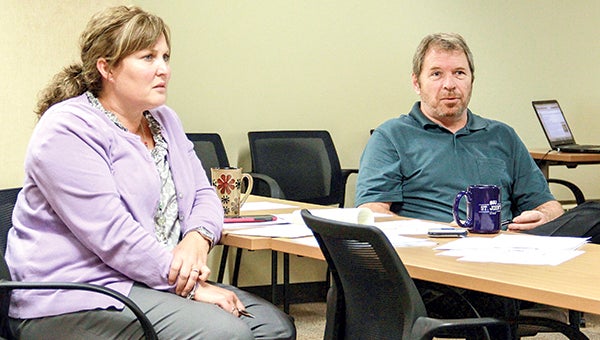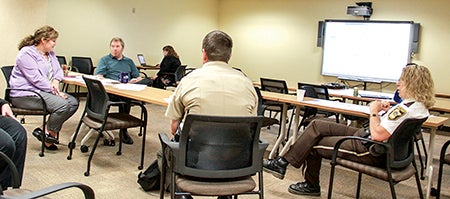Mower helps coordinate 18-county test for animal disease response
Published 11:15 am Wednesday, October 1, 2014

Mower County Emergency Management Coordinator Amy Lammey and Emergency Management Director Wayne Madson take part in Bitter Wind Functional Exercise Tuesday. The drill staged what the county would do if foot-and-mouth disease reached Mower County. — Jason Schoonover/jason.schoonover@austindailyherald.com
Environmental Services Coordinator Angie Knish sat at a laptop in the Mower County Government Center Tuesday morning searching a map of a 6.2-mile area of Mower County for the right piece of land.
Some were too close to the water table or bodies of water; others were too close to homes. After several minutes, Knish found the right spot.
Knish was looking for a place where the county could safely bury 60 or more head of cattle or pork if they had to be euthanized after contracting or being exposed to foot-and-mouth disease.
Knish’s search was just a drill, but it was part of a planning exercise that proved valuable for county officials.
“I can see where this would be convenient to have planned out ahead of time and locate one to two sites per township,” Knish told Emergency Management Coordinator Amy Lammey, who helped coordinate Tuesday’s drill.
A group of about eight to 10 Mower County and law enforcement leaders gathered Tuesday morning in the Mower County Emergency Operations Center to simulate a presumptive positive for foot-and-mouth disease, which would mean there’s a 95 to 99 percent likelihood for a positive test of the animal disease.
Though there have been no documented foot-and-mouth cases in the United States since 1929, an outbreak of the disease could have a significant economic impact.
“We just found that it was very valuable to do because of the economic effect,” Lammey said.
Planning is particularly important in Austin as Hormel Foods Corp. and Quality Pork Processors Inc. call for thousands of hogs being shipped on Interstate 90 each year.

Mower County Emergency Management Coordinator Amy Lammey, from left, Emergency Management Director Wayne Madson, Environmental Services Director Angie Knish, Sgt. David Pike and Sheriff Terese Amazi talk during the Bitter Wind Functional Exercise Tuesday. The drill stage what they’d do if foot-and-mouth disease reached Mower County.
“It can happen here, and we know that,” Sheriff Terese Amazi said. “Put your plan together before you need your plan.”
Mower was of one of 18 counties to take part in the state-coordinated exercise. Like they would in a real situation, counties participated in the exercise electronically, with officials in each county spending about three hours going through the simulated steps of their response.
Nicollet County served as the command county for the exercise called Bitter Wind Functional Exercise, which Lammey helped coordinate with help from the Department of Agriculture, Board of Animal Health, Homeland Security and Emergency Management, and they received industry support.
For the purposes of the drill, the state picked a farm at random to be the site of the presumptive positive. With the help of Geographic Information Systems (GIS) technology, the county then planned for a 6.2-mile containment around the farm, which was northeast of Brownsdale.
Emergency Management Director Wayne Madson said containment is paramount should such a disease ever reach Mower County, but it’s also complicated. There are 119 feedlots just in the simulated 6.2-mile containment area, and if an animal disease were airborne, it could spread quickly.
To keep the disease from spreading, the county would set up roadblocks at the major intersections within the containment area.
“The initial thing to is try to contain so it doesn’t keep growing,” Madson said.
Exercises like the one Tuesday serve as invaluable planning, helping counties identify strengths and weaknesses in their response efforts.
One challenge was depopulation — or disposing of diseased animals that needed to be euthanized. In such an exercise, a truckload of about 60 animals would need to be disposed of; but, worst case scenario, the county be responsible for disposing of more animals.
As shown by Knish’s search for a site, that’s not as easy as it sounds. Composting of animals can be complicated, and burials need to be far enough away from the water table sources, homes and other challenges.
“We found some shortfalls, and that’s why we do exercises is to have the shortfalls identified,” Lammey said. “We actually found more positives by a long shot.”
In several areas, the county was ahead of its own expectations. For example, Madson expected to have a hard time with control points to keep animals in the containment area, but he said they could man 25 control points with help from volunteer fire departments. Tuesday’s plan only called for about nine control points.
“We’re in a lot better shape than we thought we were going to be,” Madson said.
Lammy was happy with the county’s trusted agents, which included Amazi, Sgt. David Pike, Police Chief Brian Krueger, Fire Chief James McCoy and several other county officials. The group was pleased with the exercise.
“Everybody said it was a great exercise; we learned a lot,” Lammey said.
That initial response team would begin addressing a presumptive positive before it went public, though Lammey noted communication with the public would be important too.
Still, there were some challenges, as McCoy, Pike and Amazi discussed the challenges of disinfecting vehicles and personal pets exposed to such a disease. Though it’s rare for humans and pets — cats, dogs and horses — to contract foot-and-mouth, they can be carriers. The county would use a vinegar and bleach mix to decontaminate vehicles and boots within the containment area.
On the plus side, Mower County has practice when it comes to things like buying disinfectant and other supplies, as Amazi said such things were needed for response to the floods of 2004 and 2010.
“We plan for the worst — this would be the worst-case scenario, so we can downscale it to fit anything we’d need to do,” Lammey said.



